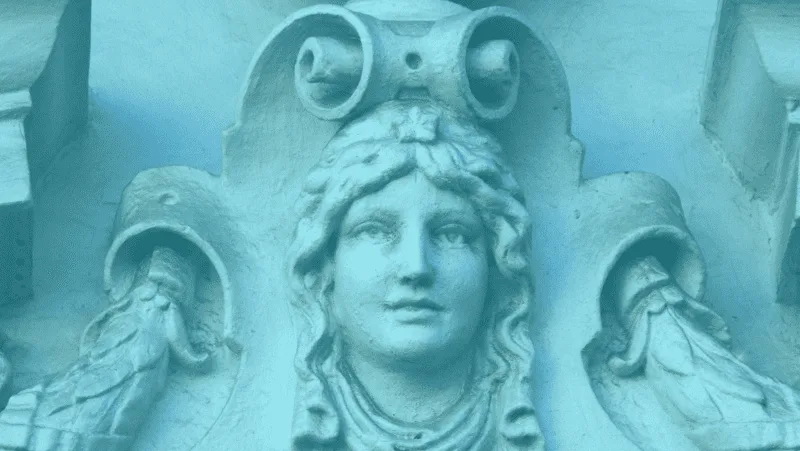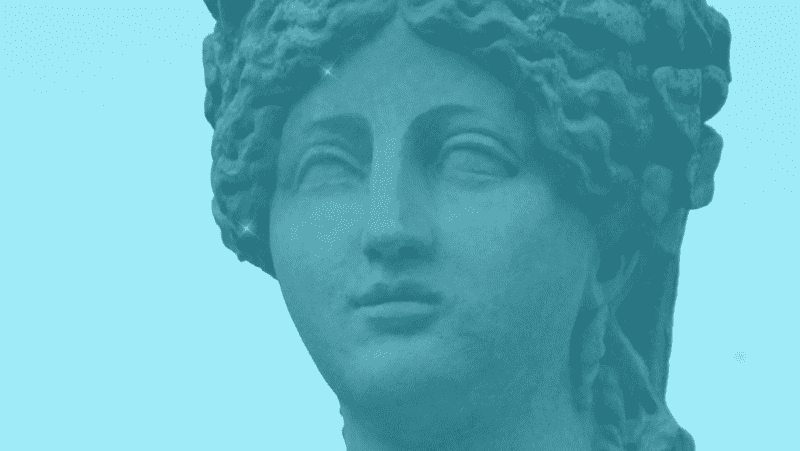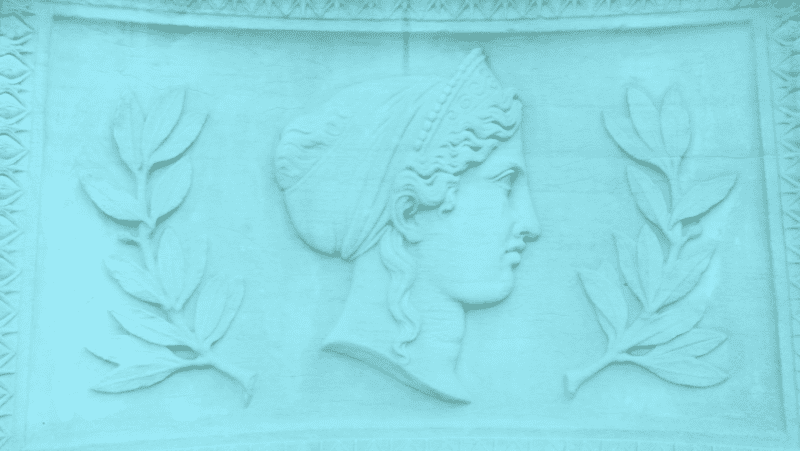Please note that posts on this site may contain affiliate links
The Greek Goddess Hera is the queen and wife of Zeus, king of gods and lord of heaven. She is also known as the goddess of marriage, motherhood, fertility, protection, war, law, justice, and the underworld. In ancient times she was worshiped at many different locations in Greece.
The etymology of the name Hera has many theories. For instance her name could be related to ὥρα hōra, season. Plato suggested it may come from ἐρατή eratē, “beloved” because Zeus married her out of love rather than duty.
Plutarch suggest the name may instead be allegorical and be an anagram for aēr (ἀήρ, “air”).
Hera is often depicted with a crown or wearing a wreath of oak leaves on her head. Her sacred animal is the peacock. She was feared by mortal women because of her tendency to punish them for her husband’s bad behavior.
Let’s explore this powerful goddess in more detail and learn about her epithets, symbols, and where her cult was centered.

The Family Of The Beautiful Goddess Hera
Hera was born to the Titaness Rhea and the god Cronus. Yep, that makes her the sister of her husband Zeus!
With Zeus, this Olympian goddess had many children. These children include the war god Ares, the goddess of youth Hebe, the deformed husband of Aphrodite Hephaestus, Angelos, Arge, the Charites, Eileithyia, Eleutheria, and Enyo.

Hera’s Symbols In Greek Mythology And Beyond
Hera has many symbols associated with her, from peacocks to livestock. Her chariot is pulled by beautiful peacocks, though these birds weren’t known by Greeks until the conquests of Alexander.
Another bird associated with Hera is the cuckoo bird. This bird appears in myths of Zeus wooing Hera to get her to marry him.
Her oldest animal associations are with cattle. One of her epithets is Boôpism or cow-eyed.
When portrayed next to Zeus, she is often shown in her true form as a beautiful older woman seated on a throne. She wears a crown or a wreath with a bridal veil. Her sceptor is topped with a pomegranate and a cuckoo.
She was depicted often on Attic red- and black-figure pottery. Sometimes she is hard to distinguish from other goddesses because she isn’t always depicted with her symbols.
Some depictions show her holding a pomegranate, which is a traditional symbol of fertility. One more symbol traditionally associated with Hera is the lily flower.
Golden apples are associated with Hera because the apple orchards of the Hesperides were given to her as a wedding gift. These are the same golden apples from which Eris’s apple of discord was stolen.

Hera’s Brutal Stories
There are many stories of Hera, but few really cast her in a positive light. Most often she is seen as cruel, vindictive, and jealous. While alternative stories exist, especially in modern feminist literature, the fact is the ancient mythology did not depict Hera kindly.
Hera and Leto
The first story of Hera I will share is of her persecuting Leto. You see, Leto slept with Zeus and conceived the twins Apollo and Artemis.
When Hera discovered that Leto was pregnant, she convinced nature spirits to refuse to allow the birth of the twins on any land attached to the earth or under the sun.
However, Poseidon felt pity for the goddess and guided her to the floating island of Delos. Because it wasn’t mainland, nor a real island, Leto was able to give birth to her twins there.
In an alternative story, Hera had to be bribed by a beautiful necklace before Leto could be allowed to rest and give birth.

Hera and Tityos
Tityos was a giant with insatiable lusts and fury. Hera went so far to punish Leto for sleeping with Zeus that she convinced the crazed giant to rape Leto.
Leto was saved by her twins, and Tityos was stretched out in Tartarus where he was tortured by two vultures that ate his liver. That liver grew back every night.
Reading this myth, I have a hard time reconciling Hera the wrathful with the modern interpretation of Hera as a goddess concerned with the welfare of women.
Hera and Heracles
Another story of Hera’s wrath is quite famous: her persecution of Heracles.
Her jealousy led her to send great serpents to the child at only eight months old. Heracles luckily was strong enough to squeeze the serpents to death.
According to Pseudo-Apollodorus, “It fell to the lot of Herakles to go mad because of the jealousy of Hera. In his madness he threw into a fire his and Megara’s children, as well as two belonging to Iphikles.”
It is Hera’s jealousy and rage that sends Heracles to complete his labors.

The Epithets Of Hera
Hera has many epithets, being one of the most important goddesses in Greek mythology.
| Epithet | Meaning |
| Ἀλέξανδρος (Alexandros) | ‘Protector of Men’ |
| Αἰγοφάγος (Aigophágos) | ‘Goat-Eater’ |
| Ἀκραῖα (Akráia) | ‘(She) of the Heights’ |
| Ἀμμωνία | Ammonia |
| Ἄνθεια (Antheia) | Flowery |
| Ἀργεία (Argéia) | ‘(She) of Argos’ |
| Βασίλεια (Basíleia) | ‘Queen’ |
| Βουναία (Bounáia) | ‘(She) of the Mound’ Derived the the son of Hermes and Alcidameia, Bunus, who built a sanctuary to Hera. |
| Βοῶπις (Boṓpis) | ‘Cow-Eyed’ ‘Cow-Faced’ |
| Λευκώλενος (Leukṓlenos) | ‘White-Armed’ |
| Παῖς (Pais) | ‘Child’ (in her role as virgin) |
| Παρθένος (Parthénos) | ‘Virgin’ |
| Τελεία (Teléia) | (as goddess of marriage) |
| Χήρη (Chḗrē) | ‘Widowed’ |
| Μονήτα (Moneta) | Used as an epithet of Hera as a patroness of coining |
| Τελχινία (Telchinia) | The Telchines were the original inhabitants of the island of Rhodes, and were said to be the first to create statues of the gods. They worshipped Hera. |
| GAME′LII (Gamêlioi theoi) | Protecting and presiding over marriage |
| HI′PPIA and HI′PPIUS (Hippia and Hippios, or Hippeios) | ‘Of horses’ |
| HYPERCHEI′RIA (Hupercheipia) | ‘The goddess who holds her protecting hand over a thing‘ |
| IMBRA′IA (Imbrasia) | Of the river Imbrasus, in Samos, where she was believed to have been born. |
| LACI′NIA (Lakinia) | Either relating to the hero Lacinius or to the gift of the Lacinian promontory given to Juno by Thetis. |
| PELASGA or PELASGIS (Pelasgis) | The Pelasgian woman or goddess. |
| PHARYGAEA (Pharngaia) | A surname of Hera, derived from the town of Pharygae, in Locris, where she had a temple. |
| SA′MIA (Samia) | Derived from her temple and worship in the island of Samos. |
| ZYGIA and ZYGIUS (Zugia and Zugios) | Surnames of Hera and Zeus as gods that preside over marriage |
| Νυμφευομενη (Nympheuomene) | Betrothed Bride |
| Αφροδιτη (Aphrodite) | Of Aphrodite |
| Ατυαρωτη (Ataurote) | Unbulled (Virginal) |
| Ολυμπια (Olympia) | Of Olympia (Elis) |
| Ἡνιοχη (Henioche) | Of the Chariot |
| Αργωια (Argoea) | Of the Ship Argo |
| Προδρομια (Prodromia) | Of the Pioneer |

Hera In Greek Religion And Her Ancient Cult
Hera had Greek temples and cult worship all across Greece. Being the queen of the gods, she was very popular among the Greeks.
There were temples dedicated to Hera in Olympia, Corinth, Tiryns, Perachora, and on the sacred island Delos. Her most notable temples were in Argos, Sparta, and Mycenae. These three cities were most beloved by the mother goddess and received her blessings and protection.
At Elis, coins depicted Hera. And all across Greece, sporting competitions called the Hereia were held in Hera’s honor. Only women competed in these sports.
Marriage festivals were in her name, as well. Couples would re-enact the marriage of Zeus and Hera in the hopes that the divine couple would bless them.
During the full moon, we call upon Hekate to assist us in clearing our past, releasing our fears, and opening ourselves to new possibilities. We ask her to help us gain clarity in our lives, to help us transform our inner worlds, and to allow us to move forward with courage and confidence.
It is said that Hekate helps us to overcome obstacles and challenges that stand in our way, and to achieve our goals. In addition to being a benevolent Goddess, she is also a fierce warrior. When we summon her, we invite her to help us take charge of our lives, to lead us into battle, and to fight for justice.
I am an eclectic witch - I've been practicing since 1974. As a student of the occult, working with astrology, tarot cards, runes, and numerology, I found that this was a very comprehensive and well written text on working with Hekate during the full moon. Highly recommended. - Gail Sager
Great read - a must have for anyone interested in working with the Goddess during the full moon! Highly recommended! - Luis Meyer


